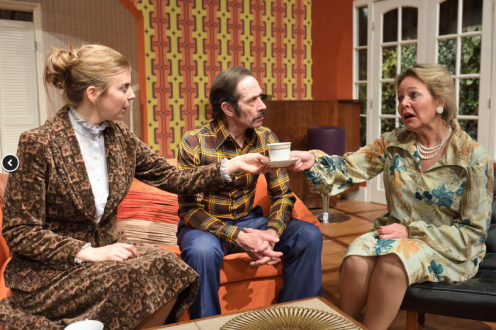Absent Friends
Suburbia Fragmented
Absent Friends
By Alan Ayckbourn
Questors at Questors Studio, Ealing until 5th January
A review by Eleanor Lewis
It’s not often you find yourself pleased by how aggressive a shirt is. And it’s probably wrong to feel like a bit of a rebel reviewer because you’re starting with the costumes. It must be said however that both costumes and set – but especially costumes – were pretty near perfect in Questors’ production of Alan Ayckbourn’s Absent Friends. Everybody on stage was cleverly dressed from the aforementioned aggressive shirt (thick brown with an angry orange stripe) worn by the bullying Paul, to the bold striped pullover sported by the uncompromising Evelyn which was almost a warning of the less-than-pliable womanhood which was just beginning to emerge in the ‘70s. This in direct contrast to the domesticated, shopping, giggling Marge in her relaxed, floral frock with incompetently hair-sprayed ‘flicks’. I could happily go on but it’s simply that the importance of costume design is often overlooked, particularly in domestic drama and the care that had been taken by Clare Malyon in this case was impressive.
Michelle Weaver’s 1970s living room set glowed with ‘burnt orange’ punctuated by a couple of ‘cooling’ leather chairs, a throbbing fire-effect fire, and was dressed with the type of hideous brown tea set, the teapot of which could have provided inspiration for Shrek in years to come. There was too, a Battenberg cake, white bread sandwiches and cheese and pineapple on sticks. Set, props and costumes take a bow, outstanding!

Absent Friends was written in 1974. It is essentially a drama about people trying and failing to conform to a social model that was no longer working. Five people calling themselves friends but who are more accurately described as people who know each other, assemble in Paul and Diana’s living room to have tea with their sixth friend Colin, whose fiancée died in a drowning accident some time before. The tea party is therefore for an ‘absent friend’ but in fact there are no real friends present.
Two and a half couples are present: Diana’s husband Paul sleeps around, she knows and makes noble but unsuccessful attempts to contain her fury; Marge, a happy character, enjoys domesticity but for her needy and constantly ill husband Gordon, present only by phone. Evelyn sits by the bar chewing gum, engages with no-one unless forced to, sleeps with whoever she pleases including Paul and rocks her baby with unconcealed contempt for the assembled company. Evelyn is married to John who is under no illusions about his wife but is probably sticking with it in the absence of a better offer. Into this mix comes Colin, the type of warm happy-go-lucky character who is initially attractive until you realise he is oblivious to the conversational needs of anyone else.
What follows is the fragmentation of the suburban, social ideal as the three couples are revealed as increasingly dysfunctional. Without reproducing a plot synopsis, Diana is forced to confront the extent to which Paul is uninterested in her, and her breakdown, as she remembers her childhood dream of joining the Royal Canadian Mounted Police and contrasts it with what her life has become, is both tragic and comic. Nina Flitman gave an understated and poignant performance as Diana that struck precisely the right tone. Lesser actors and directors would have laboured the comedy. It is Ayckbourn’s particular skill to write comedy and tragedy at the same time: performing it is challenging to say the least.

David Hovatter as the aggressive, bullying and wholly insecure Paul provided a suitably intimidating, presence on stage with a highly physical performance which gave the impression he would spark electricity if touched. Again, this was a controlled, and therefore effective, performance. Though Paul’s character was dominant, Hovatter’s performance did not dominate the other five.
It’s interesting that there is a natural focus on the women in this play, women as they were in the 50s and 60s and women as they were going to be in the 70s and 80s, but in 2018, there is also a focus on the type of man who is no longer acceptable. The bullying Paul was still tolerated in the 70s: he would not be today.

Colin, the only happy character in the mix, as played by Mark Redrup, was an ambiguous presence. His single status and his delight in his memories of what might have been had his fiancée not been lost to him was unnerving to the others. But the others at least had the ability to feel something. Colin was oblivious to the deep unhappiness of those around him, even as Diana poured cream over her errant husband, and if Colin cannot see other people’s feelings, can he really connect?
Ceri Jones as Marge was a hugely sympathetic, attractive character, restricted by her needy husband but constantly optimistic until exhaustion pins her down. She was a comforting relief from the palpable tension between the other characters. James Burgess as John was beautifully irritating with his constantly bouncing knee when he could be got to sit down, and his only partly successful decision to ignore his wife’s shortcomings. Clare Purdy as Evelyn, arguably the most straightforward to play, was blessed with a wealth of sarcastic facial expressions. These were all well observed, well-crafted performances.

I wonder how much we have moved on from the more fraught elements of 1970s suburbia. Simon Snashall’s careful direction, the skilled performances of every actor on stage and the superb support from all elements of the production staff made for an excellent production of a fascinating play. Highly recommended.
Eleanor Lewis
December 2018




